70+ Sexual Harassment in the Workplace Statistics
Let’s take a look at how serious the issue is with the following sexual harassment in the workplace statistics.

At some point during their life, 81% of women and 43% of men experience sexual harassment or assault. This is an alarming statistic for anyone to hear.
It’s practically impossible to avoid all potential sexual harassment situations because so many occur in the workplace. Just going about your daily life by showing up to work, you could still become a target.
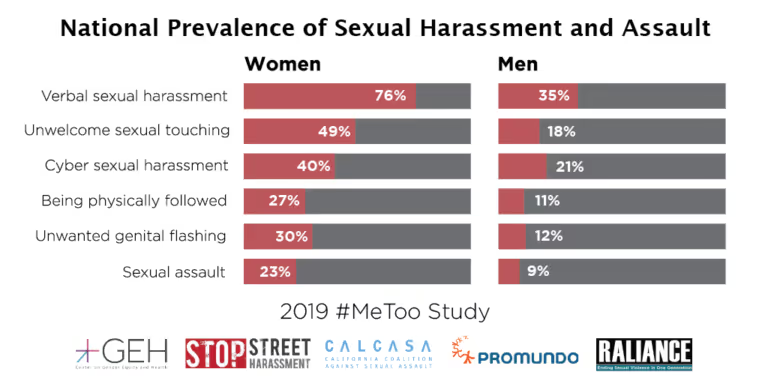
Sometimes, these incidents occur if people don’t understand what qualifies as sexual harassment. In fact, one survey found that around 16% of people didn’t know what constitutes this illegal behavior at work. Another 32% of employees didn’t know that jokes could qualify as misconduct.
So what is sexual harassment in the first place? It can include:
- Unwelcome sexual advances
- Requests for sexual favors
- Verbal or physical harassment of a sexual nature
- Offensive remarks about a person’s sex
People are more likely to be a target depending on their gender, the industry they work in, and their job positions. They may also notice more instances when working online since the harassers can hide behind a screen.
While these instances are frequent in the workplace, not everyone reports them. And even the incidents that do get reported don’t always get addressed properly. This has negative consequences for both the victims and their company.
Let’s take a look at how serious the issue is with the following sexual harassment in the workplace statistics.
General Information
This inappropriate behavior is already so common outside of the workplace. But it’s also the most common type of workplace harassment. A majority of people see it happen in their careers, or they become targets themselves. The method of offense can vary, and the number of incidents may be increasing as more charges get filed. Perhaps this is because there are still many organizations that don’t provide anti-harassment training.

- Sexual harassment is the most common form of workplace harassment, making up 50% of all complaints. (Hiscox)
- 56% of employees have witnessed or experienced sexual harassment in the workplace. (TLNT)
- In 2018, The US Equal Employment Opportunity Commission received a 13.6% increase in sexual harassment charges from the previous year. (U.S. Equal Employment Opportunity Commission)
- 36% of organizations don’t provide anti-harassment training. (Hiscox)
- Over 80% of survey respondents experience this harassment verbally. Around 44% experienced it through unwanted physical contact or sexual advances. About one quarter received at least one sexually obscene email or text message from a coworker or supervisor. (Urbanic & Associates)
Victims by Demographic

Unsurprisingly, women are more often targets than men. Both men and women are primarily targeted by people of the opposite sex.
But some do experience harassment by people of the same gender. Race, gender identity, and sexual orientation can also influence if someone becomes a target at work.
- 38% of all women said they’ve experienced sexual harassment at work. (NPR)
- Nearly 1 in 3 working women under the age of 35 has experienced sexual harassment at work at least once. Around 1 in 10 said their harasser was a female. (Urbanic & Associates)
- Of women who experience harassment, 13% were from women and 97% were from men. Of men who experience harassment, 68% were from women and 57% were from men. (Marker Medium)
- 1 in 17 sexual harassment charges reported to the EEOC alleged racial discrimination as well. (Institute for Women’s Policy Research)
- 68% of LGBT people reported being victims of harassment. (TUC)
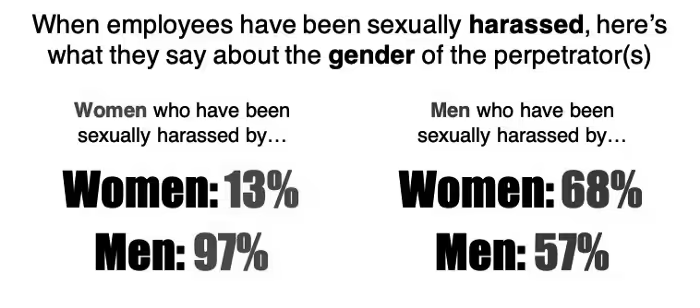
via Medium
Industries and Job Positions
Each industry’s employees face different rates of harassment. It could be due to the nature of their work or the demographics that make up a majority of the field.
Someone’s job position can have an impact as well. People in higher positions are more often harassers, abusing their privilege of power.
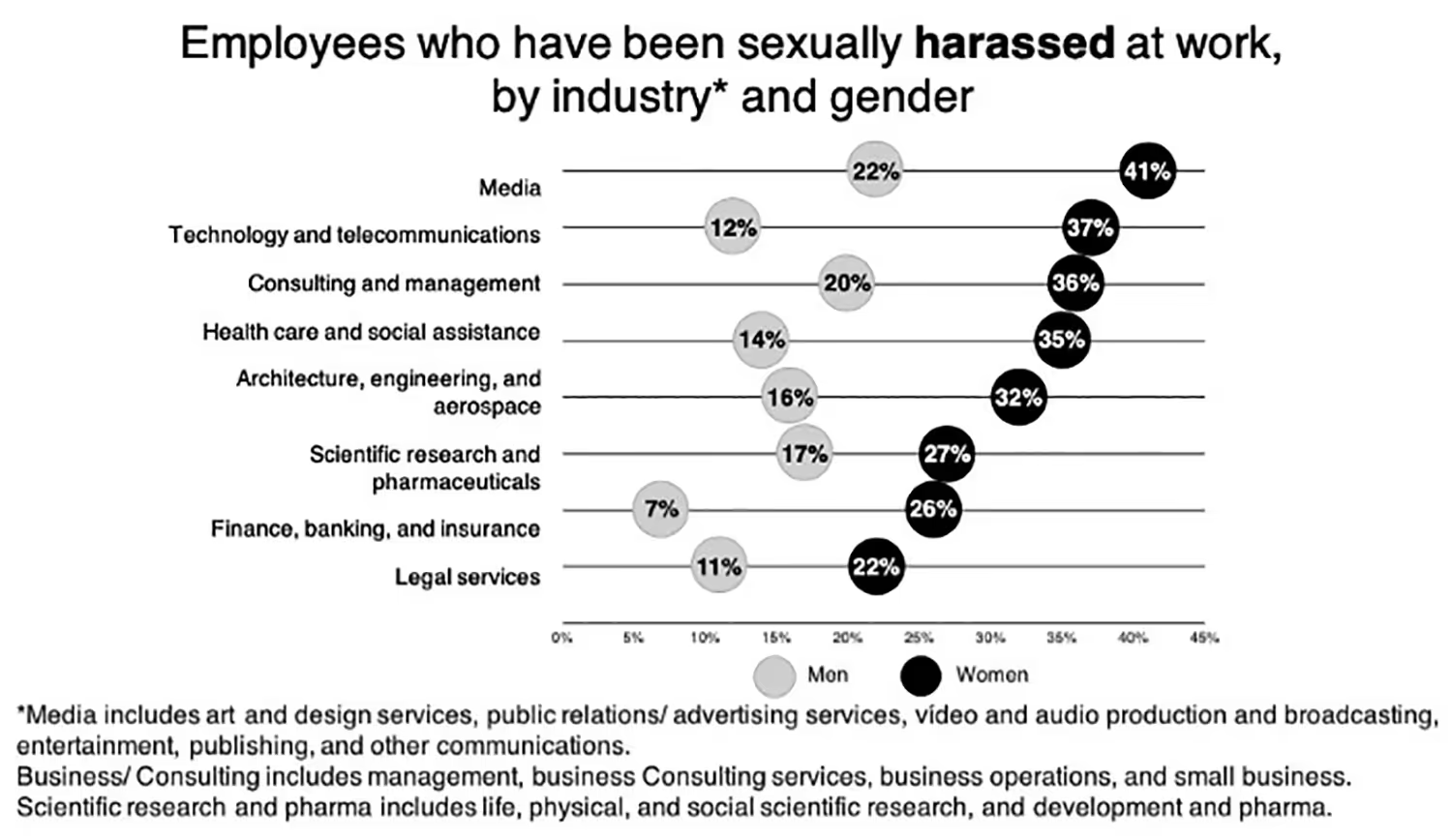
- From 2005 to 2015, 14% of harassment charges were from workers in “accommodation and food services.” These are positions typically classified as “tipped” positions. This is significantly higher than this sector’s share of total employment. (Center for American Progress)
- 71% of female restaurant employees were victims at least once during their employment within the industry. 44% were victims by someone in management. (One Fair Wage)
- In 2018, the media had the most instances of sexual harassment of either gender. 41% of targets were female employees and 22% were male employees. (Marker Medium)
- 15% of female educators and 6% of male educators are targets of harassment or assault. (Science Leadership Academy)
- 58% of harassed nurses said their perpetrators were patients, and 19% said they were the patients’ family or friends. (Nursing Times)
- 41% of female founders in the technology industry faced sexual harassment compared to just 12% of male founders. Homophobia was twice as likely for these men compared to women. No male tech founders experienced stalking, compared to 11% of females. (Statista)
- Almost three-quarters of victims experienced harassment by someone more senior than them. 57% of employees left their job due to a manager. (i-Sight)
- 23% of female victims said that their harasser had influence over their job. (Inc.)
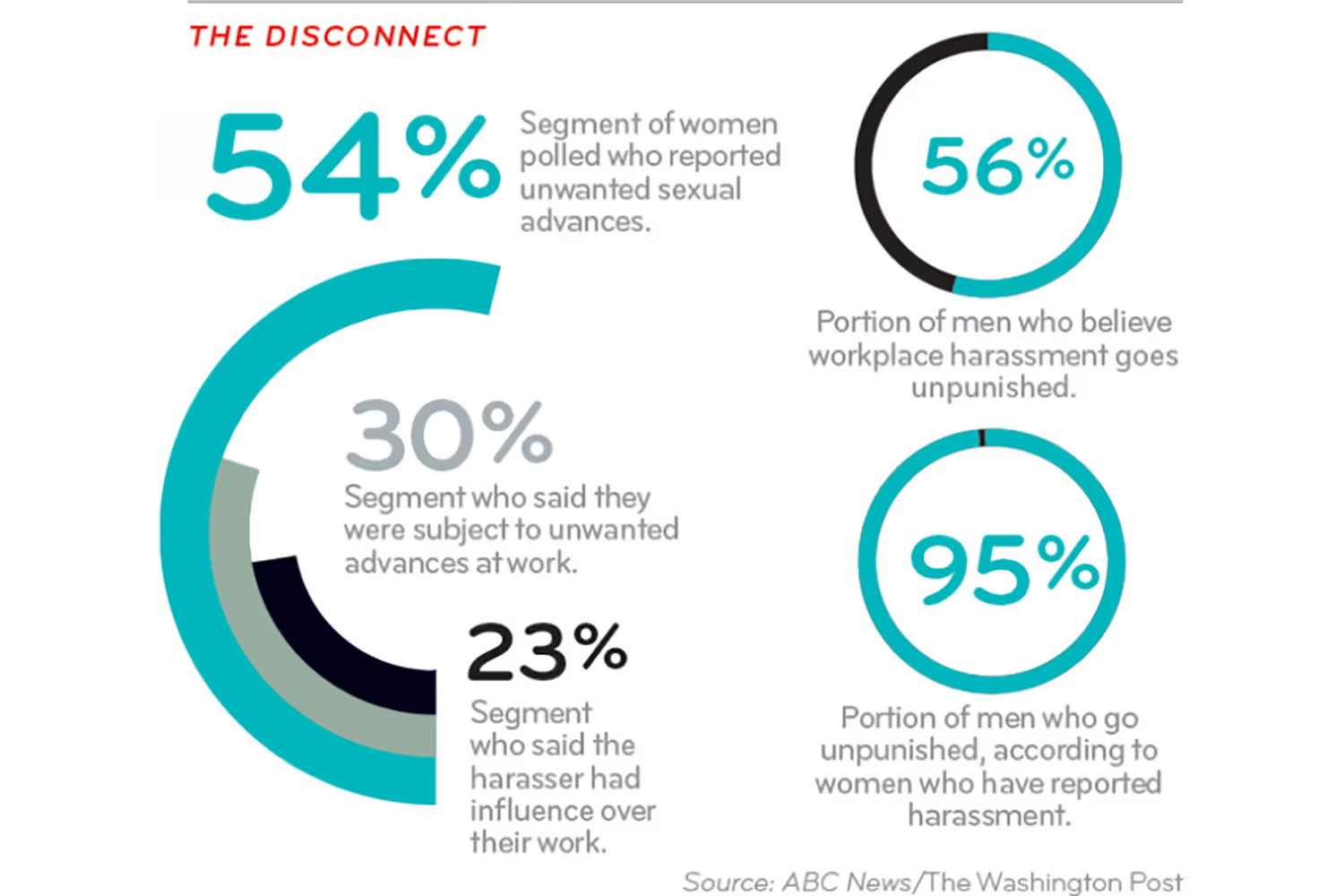
Effects of the Pandemic
During the COVID-19 pandemic, many people started working online. It might seem like instances of offensive behavior would decrease since people aren’t around each other as often. But the opposite happened. Since people weren’t face-to-face, it was easier to make inappropriate remarks in private. The pandemic also made it more challenging to make and respond to reports.
- The pandemic didn’t prevent these situations from occurring; it only increased them as they moved online. 23% of women reported an increase in online harassment during the pandemic. (Rights of Women)
- 45% of women victims reported experiencing it remotely (such as through email, texts, social media, video conferencing platforms, or phone calls). (Rights of Women)
- 29% of women who reported incidents said that the pandemic negatively impacted the response. (Rights of Women)
Reporting Incidents
Reporting an instance of these inappropriate interactions should be one of the first ways to prevent more from happening. However, many people don’t make reports.
Some don’t know how or where to do this. Others believe that nothing will get done, possibly because they’ve seen that they don’t get investigated.
And even worse, some victims who make reports end up experiencing retaliation after doing so. This is a form of unlawful discrimination against someone for engaging in a protected activity, such as filing a charge of discrimination.
It could also include discrimination against someone who participated in an investigation of workplace misconduct. Facing backlash over filing a complaint will make people unlikely to report unlawful behavior at work.
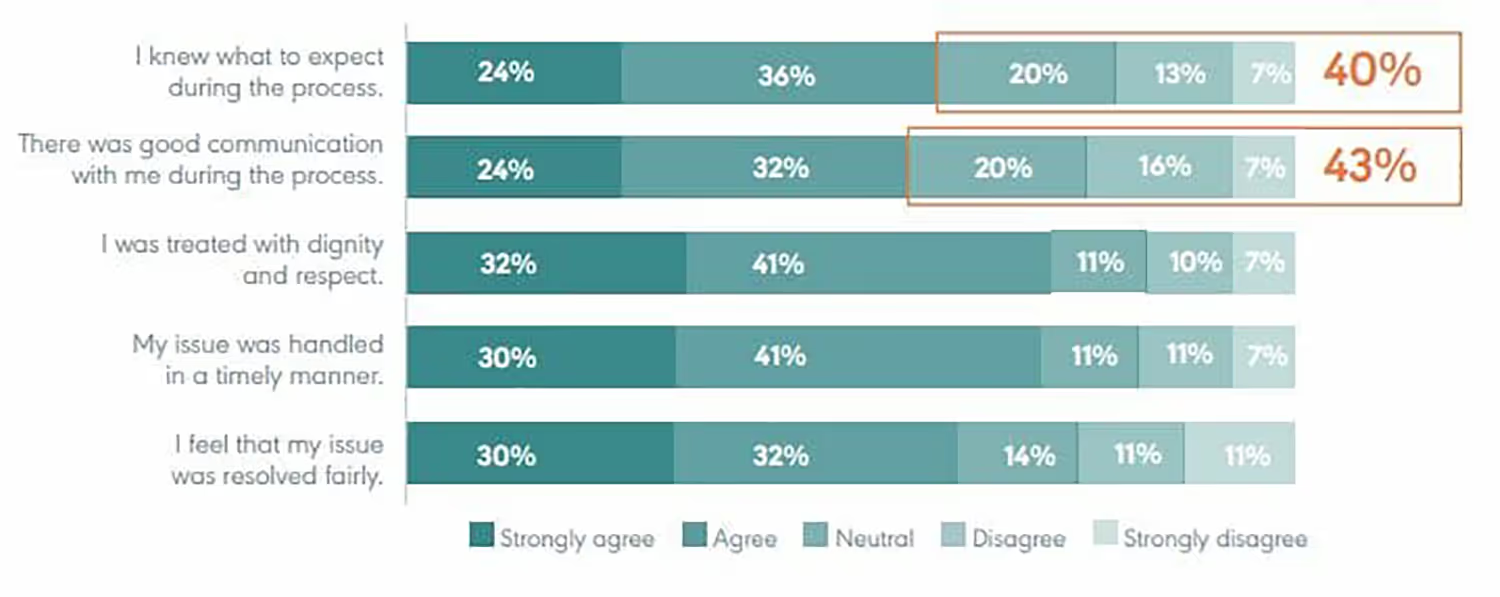
- 85% of employees know how and where to report an issue. 67% go to their managers to report a concern, but only 37% go to HR. 6% report incidents via hotlines. (HR Acuity)
- Over 70% of women who experience sexual harassment in the workplace never report the incident. (Urbanic & Associates)
- An average of 87% to 94% of people don't file complaints. (U.S. Equal Employment Opportunity Commission)
- Of 64% of employees who reported incidents, only half saw the issue get investigated. And 27% didn’t know if it was ever investigated. (TLNT)
- Concerns raised by men are 26% more likely to get investigated. (HR Acuity)
- 56% of men believe that workplace harassment goes unpunished. 95% of male harassers do go unpunished, according to women who reported incidents. (Inc.)
- Of nurses who experience incidents, men are less likely than females to make reports. Only 17% of men report incidents compared to 29% of women. (Nursing Times)
- 71 percent of charges in 2017 included a charge of retaliation. (Center for American Progress)
- 98% of harassed women employees experience at least one incident of retaliation. (One Fair Wage)
- Two-thirds of LGBT harassment victims didn’t report it to their employer. Reasons for not reporting included (TUC):
- They thought it would hurt their job (54%)
- They thought it would hurt their career (44%)
- Reporting it would reveal their sexual orientation/gender identity (25%)
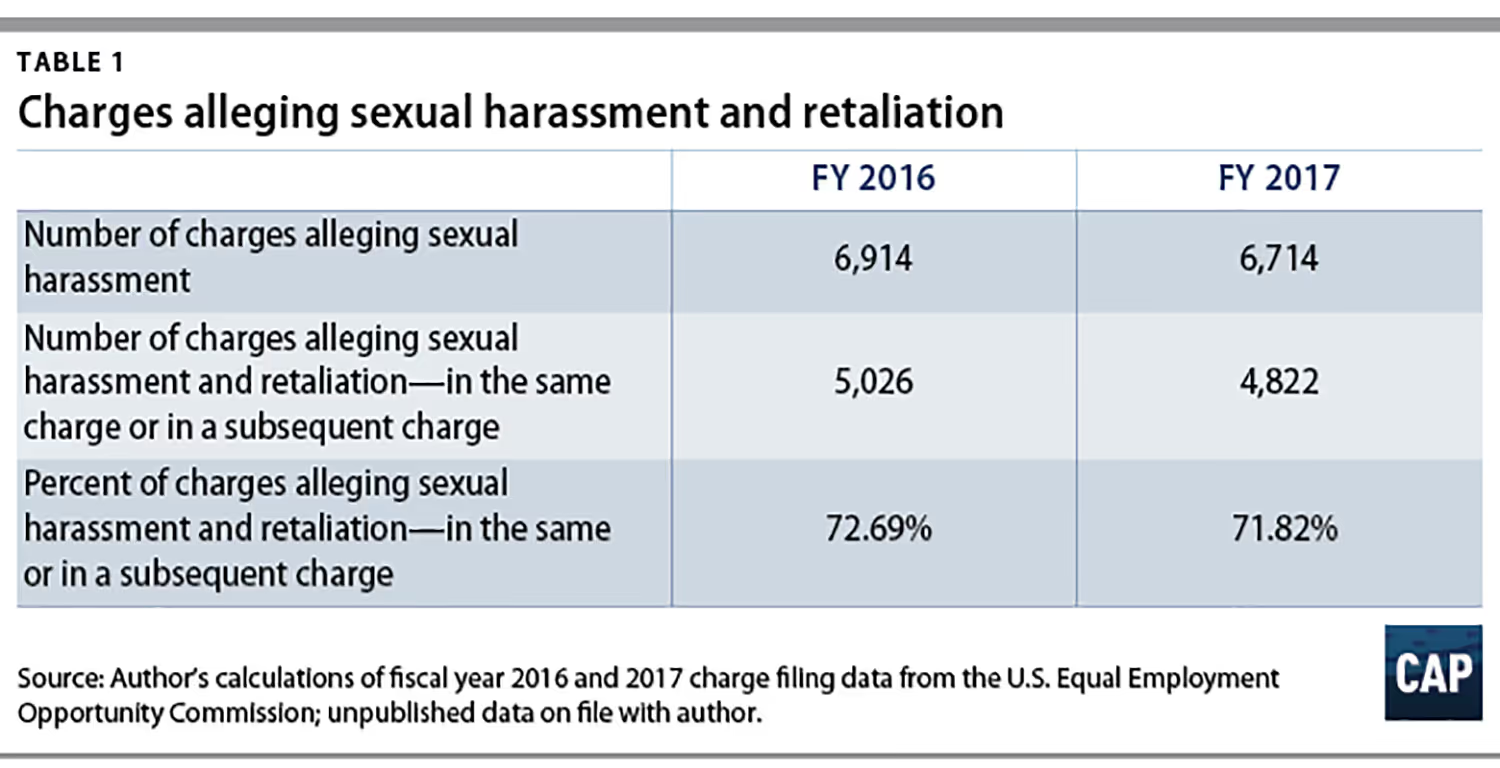
Outcomes and Costs of Harassment
Harassment has negative impacts on employees and companies. Victims are more likely to have mental health concerns after the fact.
This could lead them to take time off work or quit their job altogether. Doing so has major financial consequences for companies.
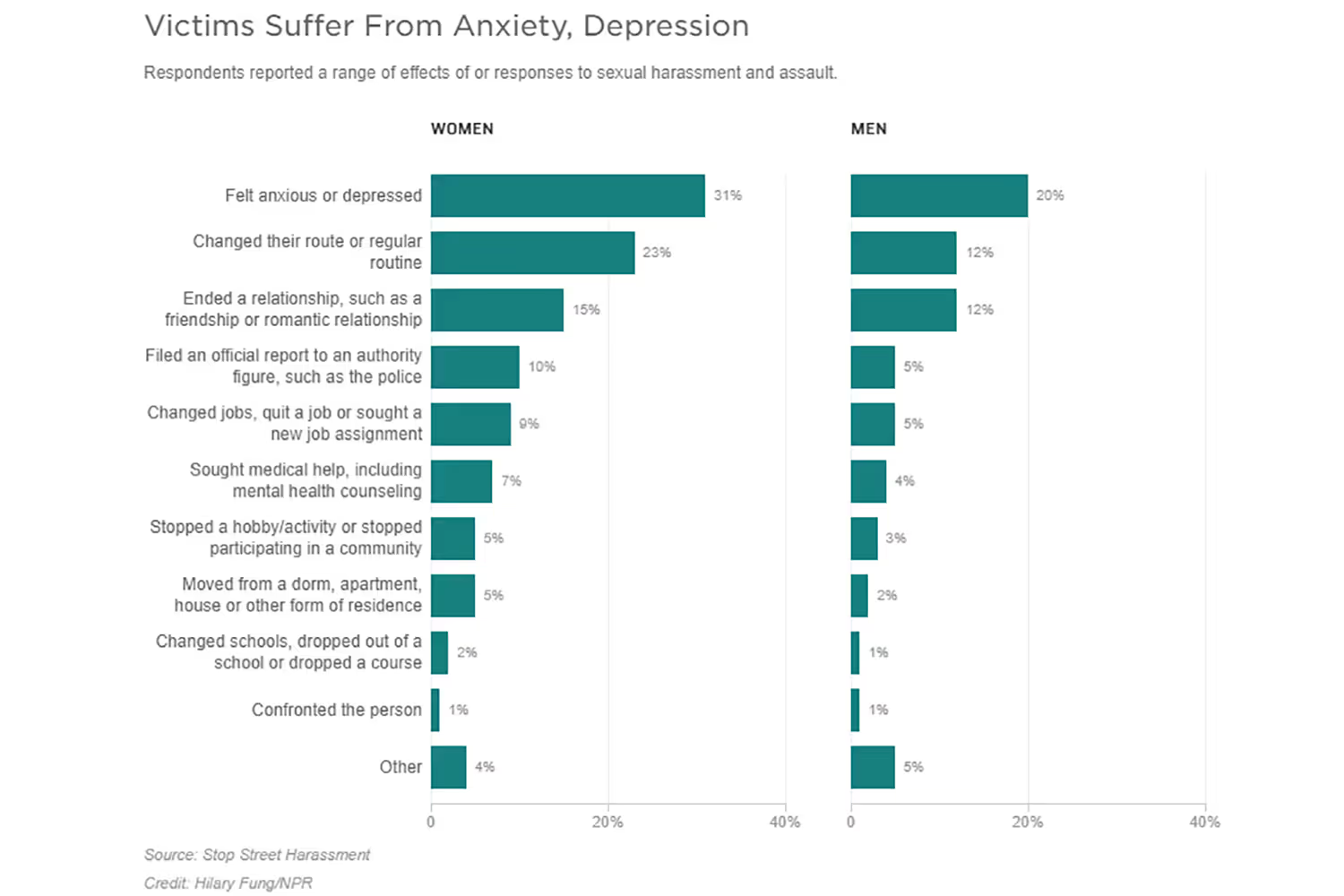
- Around 16% reported negative effects on their mental health, and 16% left their job due to the harassment. (TUC)
- Only 1% of victims of either gender confront their perpetrators. 31% of women and 20% of men experience anxiety or depression after being the victim of an incident. (NPR)
- Workplace sexual harassment leads to $2.6 billion in lost productivity ($1,053, on average, per victim. Actual or attempted sexual assault results in $249.6 million in lost well-being ($4,989 per victim). (Deloitte)
- 1 in 7 women and 1 in 17 men search for a new job due to sexual harassment or assault. (NSVRC)
- Targets are 6.5 times more likely than non-targets to change jobs. (Institute for Women’s Policy Research)
- Victims of harassment or bullying are 1.7 times more likely to have had at least two weeks off work than those who aren’t victims. One in six people who experienced sexual harassment took time off of work after the incident. (Institute for Women’s Policy Research)
- This employee turnover can cost 16-20% of an employee’s annual salary. For managerial and professional staff, the cost could be up to 213% of salary. (Center for American Progress)
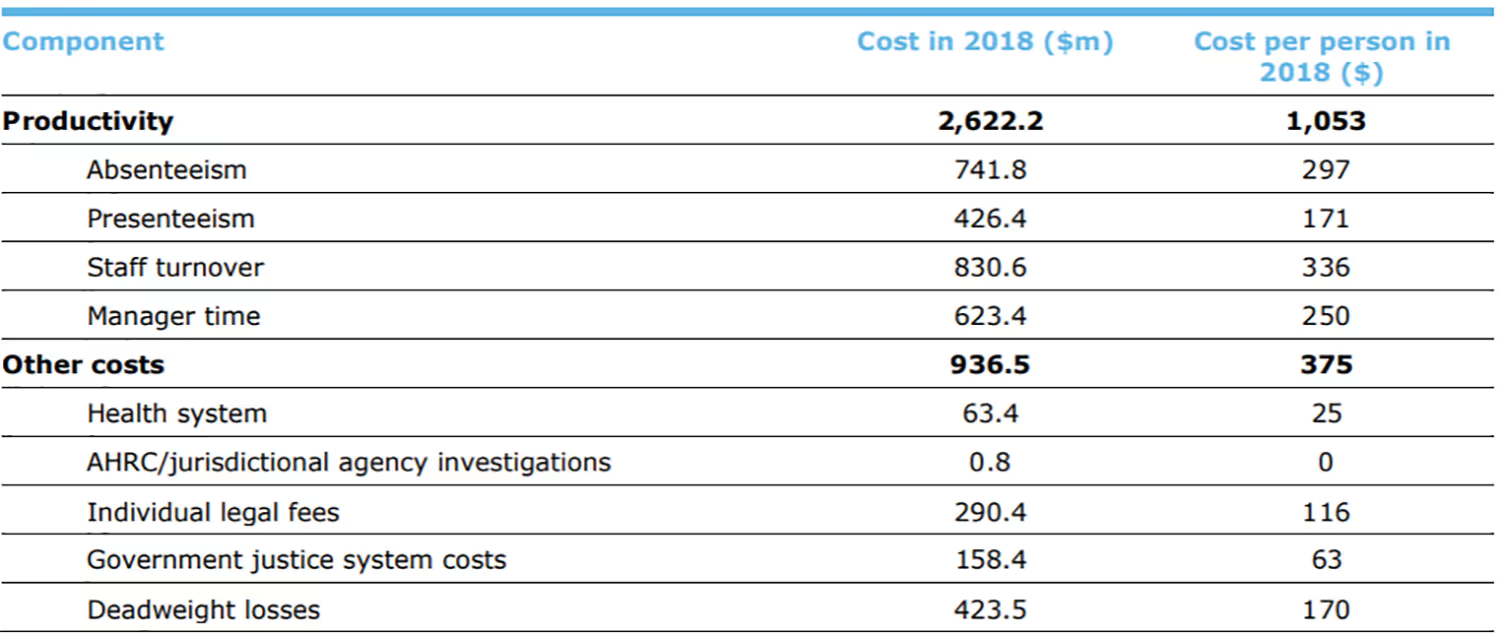
Conclusion
As of 2016, 98% of organizations had policies regarding sexual harassment. Yet even after five years, companies still face issues with this inappropriate behavior at work.
Just because there are policies in place doesn’t mean staff knows how to follow them. Training is important so these people know what qualifies as offensive behavior and how to report it. Since 36% don’t have this training, many people might not know that information.
But companies need to work on changing this so they don’t face negative costs. Addressing this kind of behavior before it can even happen helps improve the environment for employees. Everyone will know what actions or words are offensive, and people will trust that their concerns will get taken seriously.
Emphasize your product's unique features or benefits to differentiate it from competitors
In nec dictum adipiscing pharetra enim etiam scelerisque dolor purus ipsum egestas cursus vulputate arcu egestas ut eu sed mollis consectetur mattis pharetra curabitur et maecenas in mattis fames consectetur ipsum quis risus mauris aliquam ornare nisl purus at ipsum nulla accumsan consectetur vestibulum suspendisse aliquam condimentum scelerisque lacinia pellentesque vestibulum condimentum turpis ligula pharetra dictum sapien facilisis sapien at sagittis et cursus congue.
- Pharetra curabitur et maecenas in mattis fames consectetur ipsum quis risus.
- Justo urna nisi auctor consequat consectetur dolor lectus blandit.
- Eget egestas volutpat lacinia vestibulum vitae mattis hendrerit.
- Ornare elit odio tellus orci bibendum dictum id sem congue enim amet diam.
Incorporate statistics or specific numbers to highlight the effectiveness or popularity of your offering
Convallis pellentesque ullamcorper sapien sed tristique fermentum proin amet quam tincidunt feugiat vitae neque quisque odio ut pellentesque ac mauris eget lectus. Pretium arcu turpis lacus sapien sit at eu sapien duis magna nunc nibh nam non ut nibh ultrices ultrices elementum egestas enim nisl sed cursus pellentesque sit dignissim enim euismod sit et convallis sed pelis viverra quam at nisl sit pharetra enim nisl nec vestibulum posuere in volutpat sed blandit neque risus.

Use time-sensitive language to encourage immediate action, such as "Limited Time Offer
Feugiat vitae neque quisque odio ut pellentesque ac mauris eget lectus. Pretium arcu turpis lacus sapien sit at eu sapien duis magna nunc nibh nam non ut nibh ultrices ultrices elementum egestas enim nisl sed cursus pellentesque sit dignissim enim euismod sit et convallis sed pelis viverra quam at nisl sit pharetra enim nisl nec vestibulum posuere in volutpat sed blandit neque risus.
- Pharetra curabitur et maecenas in mattis fames consectetur ipsum quis risus.
- Justo urna nisi auctor consequat consectetur dolor lectus blandit.
- Eget egestas volutpat lacinia vestibulum vitae mattis hendrerit.
- Ornare elit odio tellus orci bibendum dictum id sem congue enim amet diam.
Address customer pain points directly by showing how your product solves their problems
Feugiat vitae neque quisque odio ut pellentesque ac mauris eget lectus. Pretium arcu turpis lacus sapien sit at eu sapien duis magna nunc nibh nam non ut nibh ultrices ultrices elementum egestas enim nisl sed cursus pellentesque sit dignissim enim euismod sit et convallis sed pelis viverra quam at nisl sit pharetra enim nisl nec vestibulum posuere in volutpat sed blandit neque risus.
Vel etiam vel amet aenean eget in habitasse nunc duis tellus sem turpis risus aliquam ac volutpat tellus eu faucibus ullamcorper.
Tailor titles to your ideal customer segment using phrases like "Designed for Busy Professionals
Sed pretium id nibh id sit felis vitae volutpat volutpat adipiscing at sodales neque lectus mi phasellus commodo at elit suspendisse ornare faucibus lectus purus viverra in nec aliquet commodo et sed sed nisi tempor mi pellentesque arcu viverra pretium duis enim vulputate dignissim etiam ultrices vitae neque urna proin nibh diam turpis augue lacus.




